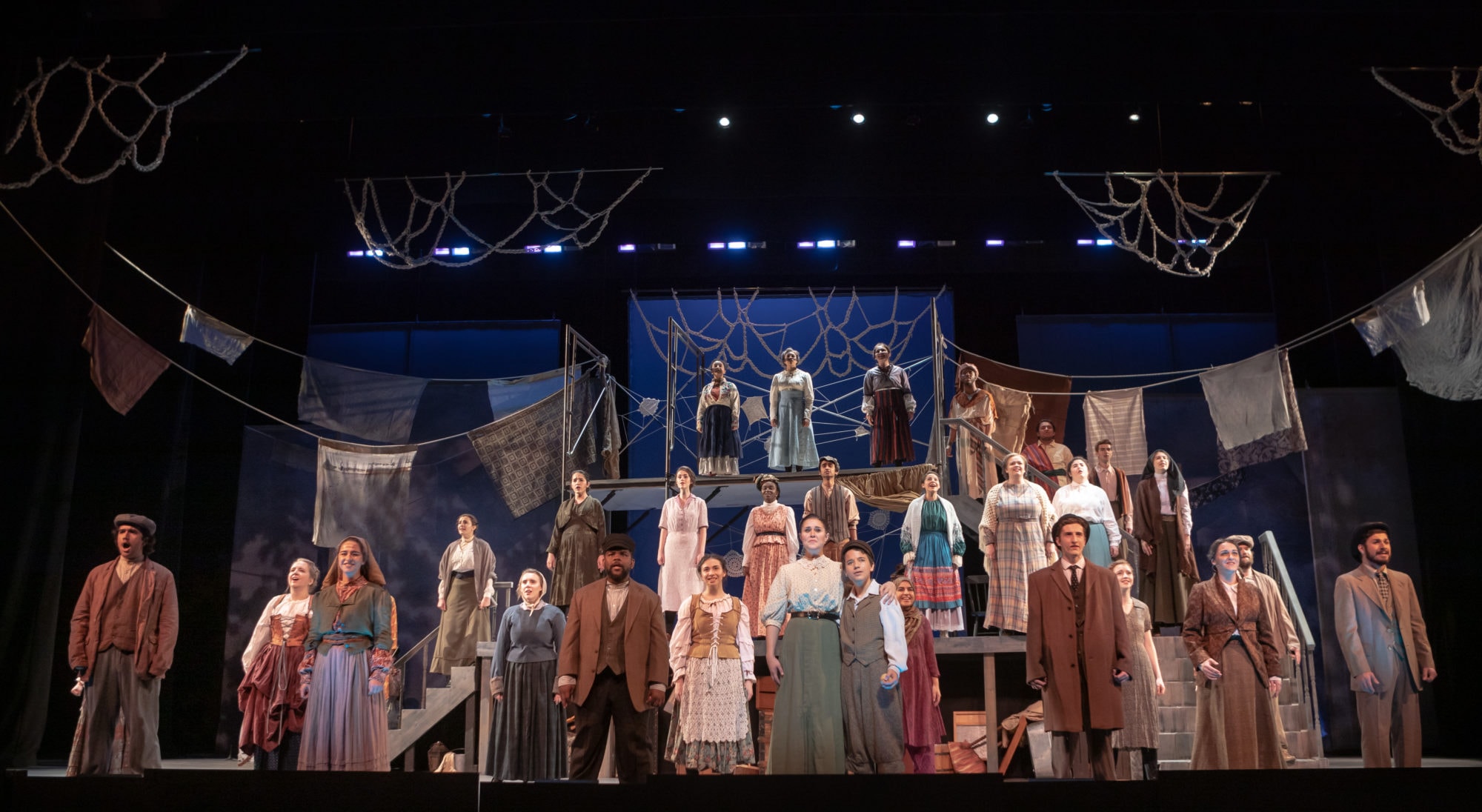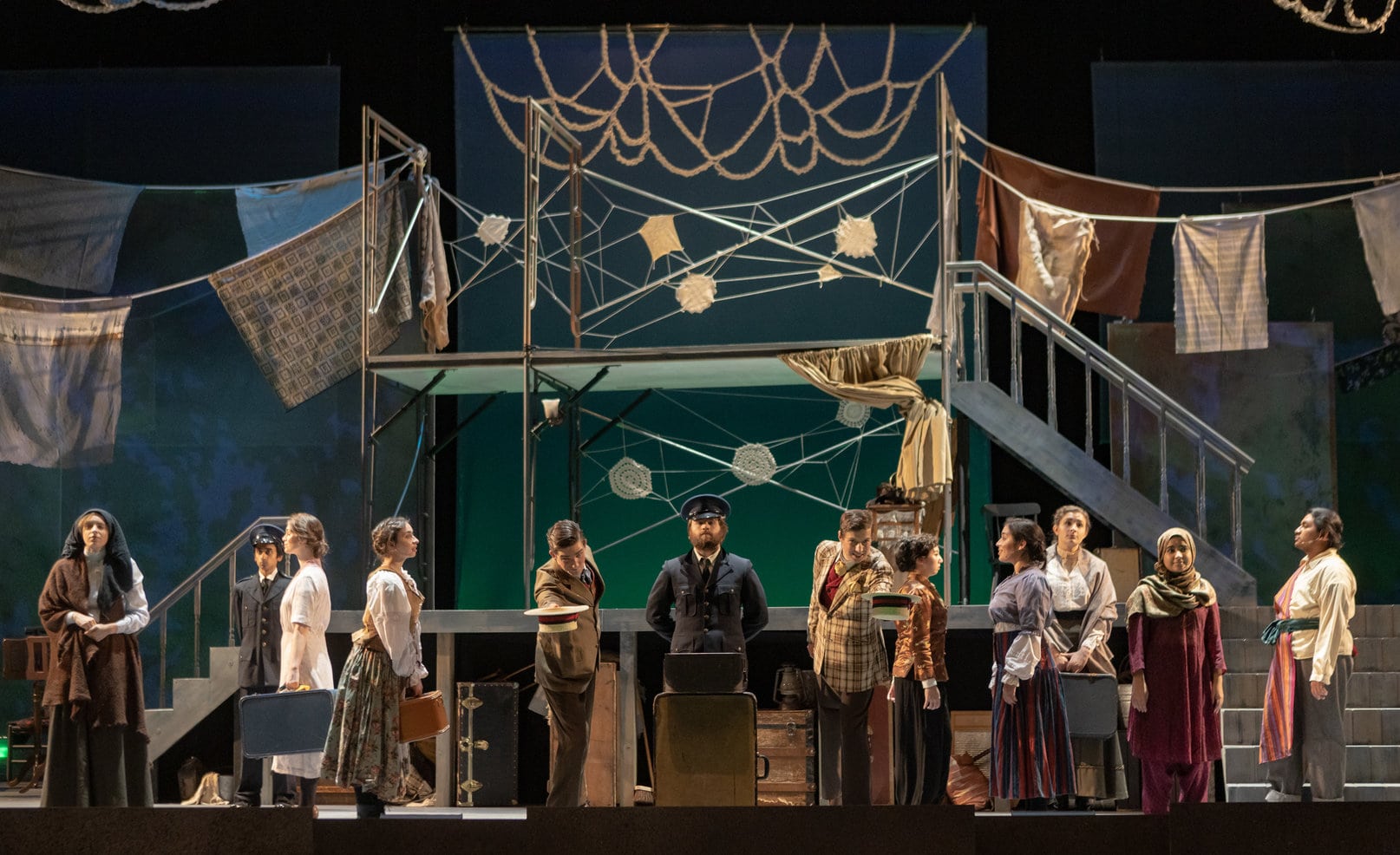Congratulations DC-area theatergoers! A new version of a major musical is being performed at George Mason University this weekend. It has legs and there are still tickets available. Rags is the DC-area premiere of the newly adapted version of the 1986 Tony-nominated musical. The audience loved the opening night, as so many aspects of this sweeping story worked beautifully.

Director Rick Davis (Dean of the College of Visual and Performing Arts) brings the combined strengths of the School of Theatre and School of Music to this story of Jewish immigrants newly arrived in America in the early 1900s. The story centers on Rebecca (a beautifully-voiced Jessica Barraclough), a young mother and widow, who hopes her sewing talents may provide a job in America. Her ocean-crossing friendship with Bella (Lauren Fraites) eases her way in a new world where she knows no one, has nothing but her drive, and does not read the language. Her struggles are those of many immigrants, from her day to the present, including cultural and language barriers, broken families, and sexism, as well as poverty and racism.
Romantic interests for Rebecca and Bella appear in the forms of the neighbor and union-leader Sal (the charismatic Tony Lemus) and co-worker Ben (a superb Claudio Manno). Sal is Italian Catholic, providing insights into cultural and religious differences, and he sings “Meet an Italian” with an operatic swagger that adds joyously to his love for baseball. Ben works in the sweatshops run by Bella’s uncle, but aspires to be a songwriter, à la Irving Berlin, writing and then singing “Bella’s Song.” All four of these actors have gorgeous voices and build intriguing characters.
Other notable characters include Bella’s father, Avram (Sam Dunn III) who is most appealing when he pretends to be Rebecca’s uncle, allowing her to proceed from Ellis Island. Although he claims to be a self-schooled scholar (similar to Fiddler on the Roof’s Tevye), his actions lack thoughtful intent, and he shows little responsibility for his destiny. This seems more of an issue with the written character than the acting. His love interest, on the other hand, the peddler Rachel, is much better written, and she is clever, quirky, and delightfully played by Julia Souza. Their song, “Three Sunny Rooms,” is joined in by Ben and Bella, and is a thorough joy.
Anna (Avram’s sister, played by Julia Rudgers) and her husband Jack (Mike Sarisky) run the tailor shop where they make dresses for Max Bronfman (Mark Zubaly). They provide a home, and a workplace in it, for Rebecca and her young son, David (Hank Hawkins). They remind one of the brusque nature and underlying heart of gold seen in the community of Fiddler’s Anatevka.
Two odd characters are the 1st and 2nd Americans (Brandon J. Morris and Josh Sheppard), who personify those in America who prey on new immigrants. Their oft-reprised song, “Greenhorns,” is funny and terrifically done, but represents a part of a mashup of styles which jars the audience focus. Their characters aren’t developed very fully and appear onstage at times as invisible observers, but who never get directly involved with the leads.

This is a big production with a company of 24 supporting the dozen leads. Opening onboard the immigrant-packed ship to America, the multi-national cast sings a lovely prologue, leading into a duet between Barraclough and Fraites, singing “If We Never Meet Again.” The song ends when characters first spy the Statue of Liberty, and the immigrants’ reaction is a moving dramatic moment. At the end of the show, Barraclough’s moving “Children of the Wind” speaks to the experience of these people pushed by powers outside of their control, before being joined by the company, who reinforce the hope that the next generation may establish roots that ground them.
The music is gorgeous with glorious singing and a strong orchestra, directed by Joseph Walsh. Four members of the orchestra also appear onstage, doubling as a klezmer band, providing authentic flavor to many scenes, such as at the Yiddish theatre, where a play within a play revises Shakespeare with a version of Hamlet, singing “Cheer up, Chaimlet.”
The unit set design by Deb Sivigny provided multiple levels for the actors to play upon, and the middle level’s size and layout seemed to constrain the characters, as it is supposed to be a small space inhabited by many. Lines tied across stage and reaching out into the sides of the auditorium, support fabric sheets suggesting drying laundry (as you might see hanging between tenement buildings in cities) or fabric used in New York City’s garment district, which is the locale for this musical. A more abstract element was the supersized lacework which also hung above the stage in enormous webs of tatting. Lighting design by Martha Mountain helped isolate focus and built tension, such as when a warehouse fire is depicted. The footlights were shielded by awkward barriers at the lip of the stage, which provided masking so the audience wasn’t annoyed by the lights in their eyes, but it obscured a few actions that occur on the stage floor.
Laurel Dunayer’s costume designs were lovely and eclectic. The wealth of those “uptown” characters, such as Max and the “Americans,” was clearly portrayed in the costumes and was opposed by the well-worn, less fancy clothes such as Ben’s suit worn for his trip to Coney Island. I also appreciated the range and diversity of costumes portrayed in the opening number, as immigrants on the boat came from multiple cultural backgrounds.
As an educator, I am delighted that George Mason University students witness and participate in the process of revision that is so crucial to creating great musicals. The creative team that is reworking this show has an incredible pedigree. The original book is by Joseph Stein, and was inspired by frequent questions asking what happened next to the characters from Fiddler on the Roof, which he wrote. Music is by Charles Strouse, Tony-award winner for Bye Bye Birdie, Applause, and Annie. Lyrics by Stephen Schwartz, famed for Godspell, Pippin, Wicked, and the Disney movies Pocahontas, Enchanted, and The Prince of Egypt. The revised book is by David Thompson, who wrote The Scottsboro Boys, Steel Pier, and the revival of Chicago. While it is not yet perfect, Rags is full of many delights, and is well worth seeing at this stage.
Running Time: Two hours and 40 minutes with a 15-minute intermission.
Rags plays through November 3, 2019, at George Mason University’s Center for the Arts- 4373 Mason Pond Drive, Fairfax, VA. For tickets, call 888-945-2468 or go online.
Note: For more on the making of Rags at George Mason University, read David Siegel’s feature here.




